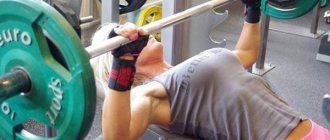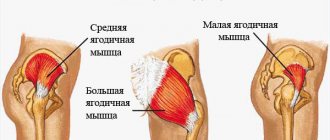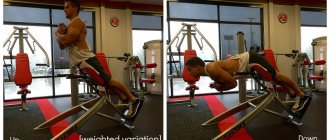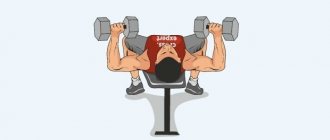The bench press is one of the most favorite exercises among gym goers. When someone finds out that you work out at the gym, the usual question is “how much do you bench press?”
The bench press is one of the mandatory exercises in powerlifting. All kinds of competitions are held on the bench press, when you need to press either the maximum weight for one time, or press a 70-100 kg barbell for the maximum number of times.
The bench press is one of the “big three” exercises: the squat, deadlift and bench press. These are the most powerful strength exercises with a barbell, in which a person is able to overcome very significant weights.
And, of course, the bench press is always included in the training programs of athletes of almost any specialization, from athletics to pure strength sports and martial arts.
What muscles does the bench press train?
The main work in the bench press, of course, is performed by the chest muscles, deltoids and triceps. However, no matter how you look at it, the bench press cannot do without the help of all other muscles. After all, you need to stabilize the position of your arms, shoulders, and whole body. Stabilizing muscles do most of the work.
Therefore, if you do the bench press seriously, the muscles of the whole body develop. But first of all, bench presses: triceps, chest muscles and deltoids.
#7 Incorrect position of the fifth point
Error
Often many people lift their butt off the bench during bench presses. In essence, this technique is cheating, reducing the effectiveness of the exercise. Due to the elevated position of the body, the trajectory of the barbell movement is noticeably reduced. As a result, your pecs work at half strength.
Solution
The fifth point should fit snugly against the bench before starting the exercise. This position must be maintained consistently throughout the repetition, even at the highest point. At the same time, do not forget about the arch in the lower back and arched chest.
What are the bench press variations?
The bench press can vary. There are quite a few variations of this great strength exercise.
Classic bench press
Simply lie down on a bench, plant your feet firmly on the floor for balance, and grab the barbell with a medium or wide grip. Perform flexion and extension of your arms until the bar touches your chest.
Powerlifting press
This is a special form of bench press. Performed with a strong deflection, on the bridge. But be sure to follow the rules: the upper back and buttocks must touch the bench.
This form of the press allows you to reduce the amplitude of the exercise and allows you to use the strongest body position. This option is used in powerlifting competitions in order to squeeze out as much weight as possible.
However, bench press lovers should be warned against thoughtlessly using this option. Without special training and development of flexibility, you risk serious injuries and sprains.
Bench press with limited amplitude
When performing a bench press, in this case the amplitude of movement of the barbell is artificially limited. For example, they put some kind of block on the chest so that the bar does not reach the chest, but stops 5-10 cm from it. This option makes sense, since the structure of muscle work and nerve impulses changes.
Another variation of the bench press with limited amplitude is the barbell bench press. Here you also do not have the opportunity to lower the barbell to your chest, since your elbows touch the floor first.
There are possible variations of the press in which the amplitude of the exercise is limited from above. That is, you do not straighten your arms to the end, stopping the barbell in the middle of the trajectory.
These presses must be performed under the supervision of a training partner.
Bench press in a power rack
A power rack is a special exercise machine with horizontal supports for the barbell. Using a power rack, you can set the supports to the desired height and perform a variety of strength exercises without the risk of being crushed by the barbell.
Performing bench presses in a power rack is one of the safest options if you don't have a partner nearby.
Smith Machine Bench Press
The Smith machine is a special simulator in which the barbell moves strictly along straight vertical guides. In this case, the bar can be fixed at any convenient height. The Smith machine eliminates the possibility of falling with the weight and allows you to safely press without the help of a partner.
As a rule, the Smith machine press is done on an incline bench.
Incline Bench Press
This variation of the barbell or dumbbell press is used to develop the upper parts of the pectoral muscles (clavicle area), which are difficult to develop with a regular bench press.
Many bodybuilding and fitness athletes do not do the usual version of the bench press at all, replacing it with the incline press.
Bench press on an incline bench
Bench presses with dumbbells
Unlike the barbell bench press, dumbbell presses have a number of advantages and disadvantages.
Benefits of dumbbell presses: Wider range of motion allowing for improved pectoral shape and flexibility. You can train with dumbbells at home. Dumbbell presses include many small stabilizer muscles in your workout.
Disadvantages: inability to perform bench presses with very heavy weights. It is impossible to perform the exercise with a dumbbell in each hand equal to half the weight of the barbell with which you are used to doing bench presses. You can usually perform the same number of repetitions with dumbbells weighing about 35-40% in each hand. This is due to the absence of a rigid biomechanical contour when working with dumbbells, which appears when working with a barbell. And this does not allow you to include all large muscles in the bench press. Efforts are dissipated to stabilize the position of the dumbbells.
Therefore, dumbbell presses are more appropriate in programs for general physical development and muscle mass. But more strength should be developed with a barbell.
Incline Dumbbell Press
Strengthening the core and continuous breathing
For moderate loads, it is worth using continuous breathing without delay - exhale for effort, inhale for relaxation.
Start exhaling a little earlier, a moment before maximum effort. This way you can do more.
Breathing should be smooth and rhythmic. Don't stop at the extremes. Immediately after inhalation, exhale without short delays.
To ensure maximum shell rigidity, try using the anchoring method. This term was first used by Dr. Stuart McGill, a lumbar spine injury and rehabilitation specialist. Bracing is the activation of the entire core muscles to create a rigid midsection, provide core stability and reduce the risk of injury.
Before lifting weights, imagine that you are about to get hit in the stomach. Tighten your abdominal and back muscles. This will create a rigid corset that you need to hold throughout the entire exercise. At the same time, breathe continuously, exhaling with maximum effort and further strengthening your core.
There is another theory about breathing during strength training. Dr. Stuart McGill and Dr. Mel Stiff believe that proper exercise technique will automatically force the body to breathe correctly, without any need for your supervision.
But this is only true for ideal technology. If you can't boast of one, work on your breathing as well as your technique.
Errors when performing the bench press
The bench press looks very simple. He lay down on the bench, took the barbell and began to press. But this is only apparent simplicity. The exercise has a lot of nuances and subtleties.
Here are the most common mistakes when performing bench presses.
No warm-up approaches
Before performing any bench press, you should perform 1-3 warm-up sets. The higher the working weight, the more warm-up approaches you need to perform.
However, do not go too heavy on the number of repetitions and weight in the warm-up. It is enough to perform 5-6 repetitions with a weight of about 50-60% of the working one.
Wrong grip
The effectiveness of the bench press directly depends on a well-chosen grip. The optimal grip width for a person of average height is 80-95 cm between the palms. But this indicator may vary depending on the structure of the chest and the height of the athlete.
It is necessary to experimentally determine the optimal grip for yourself. As a rule, it immediately provides convenience when performing a bench press and allows you to perform it with the maximum weight possible for you.
Inadequately selected working weight
The weight of the barbell or dumbbells in the bench press should correspond to the development level of the athlete. If, in order to complete the approach, you are forced to distort the exercise technique or resort to various bodily tricks, it means that the weight was chosen incorrectly.
It should be comfortable to work in the bench press. All tension should be reduced to clearly overcoming the weight of the barbell, but not to attempts to hold it in your hands and not drop it on your head or chest. Working weights in the bench press should be increased gradually, according to the set of exercises.
No insurance
The bench press falls into the category of dangerous exercises, since there is always a risk that you will be crushed by the barbell in the last repetitions. Therefore, try to do the bench press in the presence of an assistant. Or at least strangers who can come to the rescue if necessary.
A buddy is especially important if you are doing a powerful strength program using significant weights on the bar.
Beating off the chest
When performing a bench press, many inexperienced and even experienced athletes often try to hit the bar on their chest as hard as possible in order to spring and squeeze the barbell.
Avoid this mistake to avoid injury and damage to the chest, spine and ribs. Follow the advice in the next paragraph.
No delay on the chest
When performing a bench press, you should pause the bar slightly at the lowest point when the bar touches your chest. This has at least two significant advantages.
You control the bar's trajectory, making the press safer.
Holding the bar makes your muscles work harder, especially in the lift-off zone. In addition, the rules of most strength competitions require holding the barbell on your chest. Otherwise, your bench press simply will not be counted.
By holding the barbell on your chest, you ensure a safe increase in your results. Your muscles, tendons and ligaments become stronger gradually. And this process should not be forced. If you use a chop, you will be able to work with a little more weight. However, if this is abused, the ligaments that cannot keep up with the strength of the muscles may fail, and injury will occur.
Performing a barbell press without locks
If you still have little experience in the bench press, it is better to use locks that keep the plates from rolling off. Otherwise, it may turn out that the last repetitions of the bench press will lead to a distortion of the position of the barbell, and the plates on one side will move out. This will cause the bar to jerk sharply in the opposite direction, possibly causing injury.
#5 Incorrect grip
Error
One of the most serious mistakes that can cost you your health. It consists in taking the bar with a monkey grip , when all the fingers are on one side (photo on the left). It would seem that this position of the fingers seems justified: the bar is as close as possible to the lower part of the palm above the radius. This technique helps you cope with bench presses easier and even lift more weight. However, there is one “but” that covers all these advantages.
When the fingers are on one side, there is a risk of the bar falling off . This happens so quickly that even a dozen backups cannot save you. The bar may fall on your chest or throat, causing internal bleeding or simply suffocating you. It is for this reason that using a monkey grip for bench presses is often called a suicide grip , and you can only use it after making a will.
Solution
Take the barbell so that your thumb and the other four fingers are on opposite sides of the bar. Squeeze the bar tightly so that it does not move around in your palm. This way you will have complete control over the weight and protect yourself from the bar falling.
Try to hold the barbell so that the bar is closer to the bottom of your palm (photo on the right). This technique will help to avoid bending in the wrists when the working weight is too heavy.
Bench press, execution technique
Racks, barbell and bench
Use high-quality racks and a bench that prevent the bar from falling and tipping over when doing the bench press.
The bar should lie on the racks at a comfortable height for pressing, so that you can easily remove it and just as easily return it to the racks.
The bench should be neither too wide nor too narrow. You should be comfortable lying on it. Place a large towel on the bench to prevent slipping while doing the press.
Body and leg position
Lie down on the bench so that the bar of the barbell is approximately above your eyes. This way you will be able to fully control the position of the bar and see the racks when you need to return the bar to its place.
Lie down comfortably. Place your entire feet on the floor. Place them at least 60-70 cm wide to stabilize your body position. Control your body position with your legs.
Tighten your lower back and buttocks.
The head rests freely on the bench.
Many trainers advise bringing your shoulder blades together in the starting position. However, I do not recommend doing this, since you will exclude a number of necessary muscles from the exercise. Just lie naturally.
Grip
Grasp the barbell firmly, symmetrically, and with a fairly wide grip. Pay attention to the risks of the bar. They will ensure an even and symmetrical grip.
If you are sweating, it makes sense to treat your hands with chalk or magnesium. Thanks to this, the bar will not slip out of your hands at the most crucial moment. And your hands will not move apart under load.
Rod trajectory
Remove the barbell from the racks and hold it above your chest. Gently bend your arms, trying to lower the bar approximately in the nipple area. Don't lower the bar too high, too close to your neck. This is fraught with injury to the shoulder joints. Don't lower the bar too low, closer to your stomach. This way you won’t be able to overcome a large enough weight.
Accustom yourself to this basic trajectory. This is the most important part of your future bench press record - the exercise technique.
Performing a Bench Press
Lower the barbell to your chest and hold it as soon as the bar touches your body. But don’t relax, don’t let the barbell “flatten” you! A short delay and immediately an energetic press. Extend your arms. The bar should be at arm's length.
Work out the entire approach clearly and rhythmically, like clockwork, and place the barbell on the racks.
The bench press is described in more detail here.
Exhale for effort, inhale for relaxation
This is the most popular breathing advice you hear in and out of the gym: inhale when you do the easy part of the exercise, exhale when you push it.
Strong and safe movement is only possible with a rigid spine, which transmits force from large muscle groups. The spine is strengthened by tensing the core muscles - the rectus and oblique abdominal muscles, the pelvic floor muscles, and the back. During inhalation, it is impossible to tense the abs and other core muscles well, which means it is difficult to provide the necessary rigidity to the spine.
When exhaling, on the contrary, it is quite easy to tense your core muscles. Breathing affects them reflexively, through the nervous system. The muscles tighten, fixing the spine and helping to develop maximum strength. That is why the effort must be performed while exhaling.
If you pay attention to your breathing during heavy exercise, you may notice a brief cessation of breathing at the point of maximum effort. This is quite natural. Brief breath-holding is used by experienced powerlifters and weightlifters to lift heavy weights. This breathing technique is called the Valsalva maneuver, but it should be used very carefully.
How often to do the bench press
Different training systems recommend different frequencies. From three times a week to 1 time every 10-12 days.
The more weight you lift, the more days you have to rest gently after bench pressing.
The author of this article considers this schedule optimal. Do bench presses 2-3 times a week. But be sure to use the principle of load periodization. There should only be one really hard bench press workout per week. And the other 1-2 workouts should help maintain and develop the exercise technique. Such workouts are performed with medium and light weights with an increased number of repetitions.
For example:
Monday
Bench press: 5x5 (85% of maximum)
Thursday
Bench press: 4x12 (65% of maximum)
#9 Incorrect wrist position
Error
During bench presses, gravity inevitably pulls the bar and the weight down. If your wrists are bent backwards, all that force will stretch the wrist muscles. Such a mistake will significantly increase the risk of losing control of the weight or getting a wrist injury , which will take you out of the training process for a long time.
Solution
The wrists need to be aligned so that they are a continuation of the forearms: the radius bone should be strictly under the bar . If this cannot be done, it is necessary to reduce the working weight.
#11 Bar tilt
Error
A common mistake beginners make when bench pressing is tilting one side of the bar , as a result of which the bar is no longer parallel to the floor.
This mistake is largely due to the fact that one hand is usually more developed than the other. Also, bench presses involve the work of a large number of muscles, and coordinating their work is not so easy. Unsynchronization of movements leads to uneven lowering of the bar. It begins to fall to one side, loading the pectorals differently.
Solution
Try not to look at your right or left hand, but direct your gaze strictly in the center . Take the bar so that your hands are at the same distance from the center: the notches will help you with this.
If the problem cannot be solved, try training with less weight and working on the tenc.
Rate Instagram
irongenerationru
Good night ⠀ Lots of good stuff
Bring sports to the masses! Go ahead
The angle is just right ⠀ A bunch of good ones
Bring sports to the masses! Go ahead
Load more... Follow instructions on Instagram











